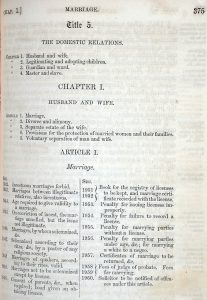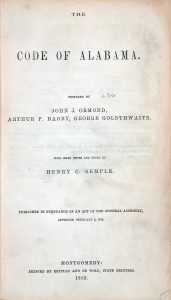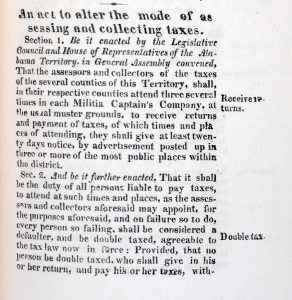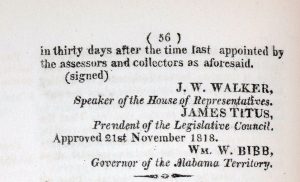An Exhibit: Early Statutory Compilations and Codes
- April 25th, 2018
- by specialcollections
- in Collections, Exhibits
The books presented in this post may seem to be nothing more than dusty old lawbooks, but they are in fact the mortal remains of Alabama’s frontier period. The energetic, mostly young men who made up Alabama’s legislatures faced the issues—national and local—of Jacksonian America. In response they spelled out their attitudes, self-interests, and startling biases for future generations to ponder. So in the adventurous spirit of that time, we invite our readers to read the signposts of what were once new ideas. We encourage you to visit our physical exhibit “Early Statutory Compilations and Codes” located in the main hall of UA’s Law Library.
Early Statutory Compilations and Codes
Occupying a parallel universe to Alabama’s case law, the state’s early statutory laws were diligently compiled every ten years. The legislature gave this task to highly regarded lawyers and judges who made every effort to produce volumes that would be intelligible to lawyers and lay persons. These compilers and codifiers kept in mind the frontier conditions prevailing over most of the state; they knew that these volumes were going to be packed in saddlebags and carried “on circuit.”
1823: The state of Alabama’s first statutory compilation was assembled by Harry Toulmin, a long-tenured territorial judge who had previously published “digests” of legislation for Kentucky (1802) and the Mississippi Territory (1807). Toulmin’s 1823 Digest of the Laws of the State of Alabama . . . is an important source of Mississippi legislation—relevant to early Alabama lawyers since Alabama had been, from 1798 to 1817, the eastern half of the Mississippi Territory. Arranged alphabetically, Toulmin’s Digest was the final masterpiece of a long life of service. Assisted by the distinguished attorney Henry Hitchcock, Toulmin worked confidently, subdividing statutes, adding historical notes, and omitting obsolete sections.
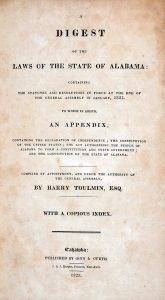
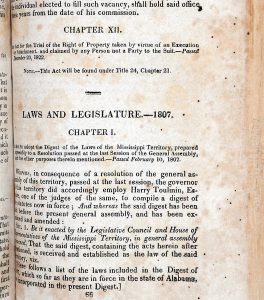
1833: John G. Aikin published the state’s first decennial digest in 1833. Aikin followed the same alphabetical arrangement as Toulmin, with helpful marginal notes and a copious index. In addition he provided an appendix containing the “Rules of Proceedings and Practice in the Courts.” The latter was needed, since in 1832 the legislature had created a three-judge Supreme Court, replacing the banc of circuit judges who had previously served as the state’s appellate tribunal. Aikin reissued his Digest with a supplement in 1836. Attorney and belletrist Alexander B. Meek published Meek’s Supplement in 1841, containing a militia code and important changes in chancery practice that had been adopted by the Supreme Court in January 1841.
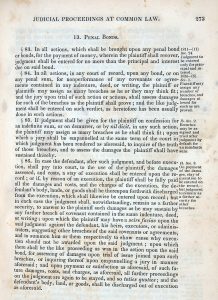
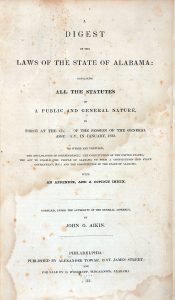
1843: Alabama’s second decennial compilation was published in 1843. Its author was Clement Comer Clay, one of the state’s most notable and controversial Jacksonian Democrats. Clay served as governor from 1835 to 1837; from 1837 to 1841 he was U.S. senator from Alabama. The result of his labors was strikingly similar to that employed by Aikin. Like Aikin he included court rules—in Clay’s case, rules for the Supreme Court, circuit courts, county courts, and chancery courts, as well as treatments of judicial procedures in common law and chancery.
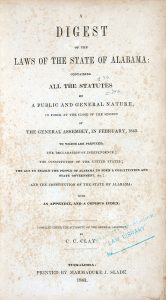
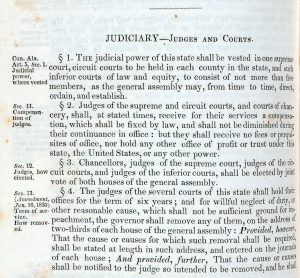
1852: The 1840s witnessed a national discussion of codification, culminating in New York’s celebrated Field Code. In 1849 Governor Henry W. Collier proposed creation of an Alabama code commission. Lawmakers complied and a commission headed by Collier’s former colleague John J. Ormond set to work. In February 1852 the legislature adopted the code they had produced. The 1852 Code of Alabama was controversial because of the modifications its authors made in the state’s common law pleading. Yet their work provided the foundation for Alabama codes for many decades.
